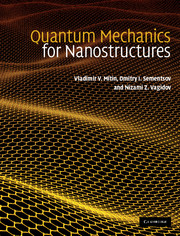Book contents
- Frontmatter
- Contents
- Preface
- List of notation
- 1 The nanoworld and quantum physics
- 2 Wave–particle duality and its manifestation in radiation and particle behavior
- 3 Layered nanostructures as the simplest systems to study electron behavior in a one-dimensional potential
- 4 Additional examples of quantized motion
- 5 Approximate methods of finding quantum states
- 6 Quantum states in atoms and molecules
- 7 Quantization in nanostructures
- 8 Nanostructures and their applications
- Appendix A Classical dynamics of particles and waves
- Appendix B Electromagnetic fields and waves
- Appendix C Crystals as atomic lattices
- Appendix D Tables of units
- Index
8 - Nanostructures and their applications
Published online by Cambridge University Press: 05 June 2012
- Frontmatter
- Contents
- Preface
- List of notation
- 1 The nanoworld and quantum physics
- 2 Wave–particle duality and its manifestation in radiation and particle behavior
- 3 Layered nanostructures as the simplest systems to study electron behavior in a one-dimensional potential
- 4 Additional examples of quantized motion
- 5 Approximate methods of finding quantum states
- 6 Quantum states in atoms and molecules
- 7 Quantization in nanostructures
- 8 Nanostructures and their applications
- Appendix A Classical dynamics of particles and waves
- Appendix B Electromagnetic fields and waves
- Appendix C Crystals as atomic lattices
- Appendix D Tables of units
- Index
Summary
Nanotechnology is based on the ability to manipulate individual atoms and molecules in order to assemble them into bigger structures. Such artificial nanoscale structures, usually fabricated using self-assembly phenomena, possess new physical, chemical, and biological properties. The fabrication of various types of nanostructures and study of their properties require new technological means and new principles.
Nanotechnology has initiated a new so-called bottom-up technology. The bottom-up technology is based on the self-assembly phenomenon, i.e., the process of formation of complex ordered structures from simpler ones. The main idea of this technology is in the development of the controlled self-assembly of the atoms, molecules, and molecular chains into nanoscale objects. The bottom-up technology allows the fabrication of nanoobjects, such as quantum dots, quantum wires, and superlattices.
The bottom-up approach is opposite in principle to the traditional approach, which may be called the top-down approach, which is based on the sequential decrease of the object's size by means of mechanical or chemical processing for the fabrication of objects of nanoscale size (nanoobjects). Thus, for example, some of the nanoparticles can be obtained by grinding material consisting of particles of micrometer or larger size in a special grinder. The traditional technologies include laser methods for the processing of semi-conductor surfaces and making masks of various configurations and sizes for photolithography.
In this chapter we will briefly consider the main fabrication and characterization techniques for nanostructures and will give some examples of applications of nanostructures in modern nanoelectronics.
- Type
- Chapter
- Information
- Quantum Mechanics for Nanostructures , pp. 258 - 309Publisher: Cambridge University PressPrint publication year: 2010
- 2
- Cited by

